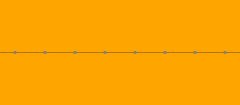Dihedron
| Set of regular n-gonal dihedra | |
|---|---|
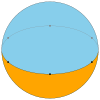 Example hexagonal dihedron on a sphere | |
| Type | Regular polyhedron or spherical tiling |
| Faces | 2 n-gons |
| Edges | n |
| Vertices | n |
| Vertex configuration | n.n |
| Wythoff symbol | 2 | n 2 |
| Schläfli symbol | {n,2} |
| Coxeter diagram |
|
| Symmetry group | Dnh, [2,n], (*22n), order 4n |
| Rotation group | Dn, [2,n]+, (22n), order 2n |
| Dual polyhedron | hosohedron |
A dihedron is a type of polyhedron, made of two polygon faces which share the same set of edges. In three-dimensional Euclidean space, it is degenerate if its faces are flat, while in three-dimensional spherical space, a dihedron with flat faces can be thought of as a lens, an example of which is the fundamental domain of a lens space L(p,q).[1]
Usually a regular dihedron is implied (two regular polygons) and this gives it a Schläfli symbol as {n,2}. Each polygon fills a hemisphere, with a regular n-gon on a great circle equator between them.[2]
The dual of a n-gonal dihedron is the n-gonal hosohedron, where n digon faces share two vertices.
As a polyhedron
A dihedron can be considered a degenerate prism consisting of two (planar) n-sided polygons connected "back-to-back", so that the resulting object has no depth.
As a tiling on a sphere
As a spherical tiling, a dihedron can exist as nondegenerate form, with two n-sided faces covering the sphere, each face being a hemisphere, and vertices around a great circle. (It is regular if the vertices are equally spaced.)
The regular polyhedron {2,2} is self-dual, and is both a hosohedron and a dihedron.
| Image | 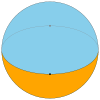 |
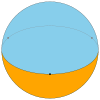 |
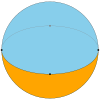 |
 |
 |
| Schläfli | {2,2} | {3,2} | {4,2} | {5,2} | {6,2}... |
|---|---|---|---|---|---|
| Coxeter | |||||
| Faces | 2 {2} | 2 {3} | 2 {4} | 2 {5} | 2 {6} |
| Edges and vertices |
2 | 3 | 4 | 5 | 6 |
Apeirogonal dihedron
In the limit the dihedron becomes an apeirogonal dihedron as a 2-dimensional tessellation:
Ditopes
A regular ditope is an n-dimensional analogue of a dihedron, with Schläfli symbol {p, ... q,r,2}. It has two facets, {p, ... q,r}, which share all ridges, {p, ... q} in common.[3]
See also
Notes
- ↑ Gausmann, Evelise; Roland Lehoucq; Jean-Pierre Luminet; Jean-Philippe Uzan; Jeffrey Weeks (2001). "Topological Lensing in Spherical Spaces". Classical and Quantum Gravity. 18: 5155–5186. arXiv:gr-qc/0106033
 . doi:10.1088/0264-9381/18/23/311.
. doi:10.1088/0264-9381/18/23/311. - ↑ Coxeter, Regular polytopes, p. 12
- ↑ Regular Abstract polytopes, p. 158
References
- McMullen, Peter; Schulte, Egon (December 2002), Abstract Regular Polytopes (1st ed.), Cambridge University Press, ISBN 0-521-81496-0
- Coxeter, H.S.M.; Regular Polytopes (third edition). Dover Publications Inc. ISBN 0-486-61480-8
- Weisstein, Eric W. "Dihedron". MathWorld.
